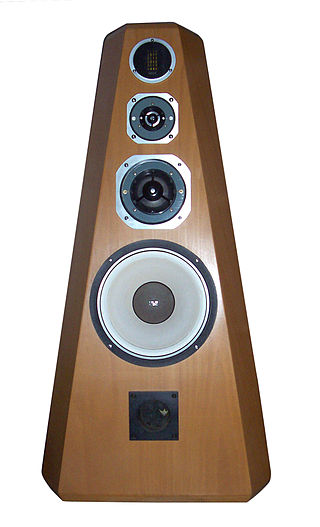
High fidelity is the high-quality reproduction of sound. It is popular with audiophiles and home audio enthusiasts. Ideally, high-fidelity equipment has inaudible noise and distortion, and a flat frequency response within the human hearing range.
Downtempo is a broad label for electronic music that features an atmospheric sound and slower beats than would typically be found in dance music. Closely related to ambient music but with greater emphasis on rhythm, the style may be played in relaxation clubs or as "warm-up or cool-down" music during a DJ set. Examples of downtempo subgenres include trip hop, ambient house, chillwave, psybient and lofi hip hop.
The time loop or temporal loop is a plot device in fiction whereby characters re-experience a span of time which is repeated, sometimes more than once, with some hope of breaking out of the cycle of repetition. Time loops are constantly resetting; when a certain condition is met, such as a death of a character or a certain point in time, the loop starts again, possibly with one or more characters retaining the memories from the previous loop.

Fidelity is the quality of faithfulness or loyalty. Its original meaning regarded duty in a broader sense than the related concept of fealty. Both derive from the Latin word fidēlis, meaning "faithful or loyal". In the City of London financial markets it has traditionally been used in the sense encompassed in the motto "my word is my bond".
Chill-out is a loosely defined form of popular music characterized by slow tempos and relaxed moods. The definition of "chill-out music" has evolved throughout the decades, and generally refers to anything that might be identified as a modern type of easy listening.
A scar is a mark left behind after a wound has healed.

Lo-fi is a music or production quality in which elements usually regarded as imperfections in the context of a recording or performance are present, sometimes as a deliberate choice. The standards of sound quality (fidelity) and music production have evolved over the decades, meaning that some older examples of lo-fi may not have been originally recognized as such. Lo-fi began to be recognized as a style of popular music in the 1990s, when it became alternately referred to as DIY music. Some subsets of lo-fi music have become popular for their perceived nostalgic and/or relaxing qualities, which originate from the imperfections that define the genre.
In Unix-like operating systems, a loop device, vnd, or lofi is a pseudo-device that makes a computer file accessible as a block device.

Akira the Don is a British musician, DJ, producer, and YouTuber.
Fidelity is the quality of faithfulness or loyalty.
High fidelity or hi-fi is most commonly a term for the high-quality reproduction of sound or images.
Lo-fi photography refers to unconventional photographic practices, chosen for aesthetics, which give an impression of low quality. Popular techniques include the use of toy cameras or pinhole cameras, for their distinctive stylistic effects. It can be considered a reaction to the perceived ease of creating technically perfect photos in the digital age. Some emphasize a return to film, while others use digital technology to accomplish the same effects. Low-fidelity photography has also been commonly linked with lo-fi music as well.
Ladies who lunch is a phrase referring to a type of well-off, well-dressed women.

Lofi hip hop is a form of downtempo music that combines elements of hip hop and chill-out music. It was popularized in the 2010s on YouTube.

Kind Words (lo fi chill beats to write to) is a 2019 casual video game developed by American indie developer Popcannibal, consisting of programmer and designer Ziba Scott and artist Luigi Guatieri. The game was first released as a Humble Bundle Original in July 2019, and was released on Steam in September 2019. In the game, the player can send and request letters to and from other players anonymously over the internet, while lo-fi music plays in the background.

Lofi Girl is a French YouTube channel and music label established in 2017. It provides livestreams of lo-fi hip hop music 24/7, accompanied by a Japanese-style animation of a girl studying or relaxing in her bedroom with a cat on the window.
This page is based on this
Wikipedia article Text is available under the
CC BY-SA 4.0 license; additional terms may apply.
Images, videos and audio are available under their respective licenses.






